All you need to know about Lofoten Islands
If you are going to organize a DIY trip to the Lofoten Islands, first let me say that you have had a great idea.
Regardless of the period in which you are planning your departure, this land of fishermen, fjords, wooden houses by the sea, northern lights and midnight sun will enter your heart.
It is worth going to the Lofoten Islands only if you are willing to understand that nature still dominates man hereand not vice versa.
That you can get excited in front of so much beauty and that yes, some shows really exist. In this place peace is palpable, so much so that hearts synchronize and make them beat at the same speed with which a snowflake lands on the ground.
With the advice you are about to read, you will be able to make the most of this trip to the Lofoten Islands.
Are you ready? Let’s go!
Table of Contents
1: When to go to the Lofoten Islands: the best period
The sea and the currents mitigate the climate and, for this reason, the temperature never drops too much below zero.
January and February are the coldest months, with an average temperature of -1°C.
July and August are the warmest, with an average temperature of 16°C.
October is the wettest month. Strong winds can occur especially in late fall and winter.
You have to choose responsibly when to go to the Lofoten Islands to be prepared in the right way, because let’s remember: we are 200km north of the Arctic Circle!
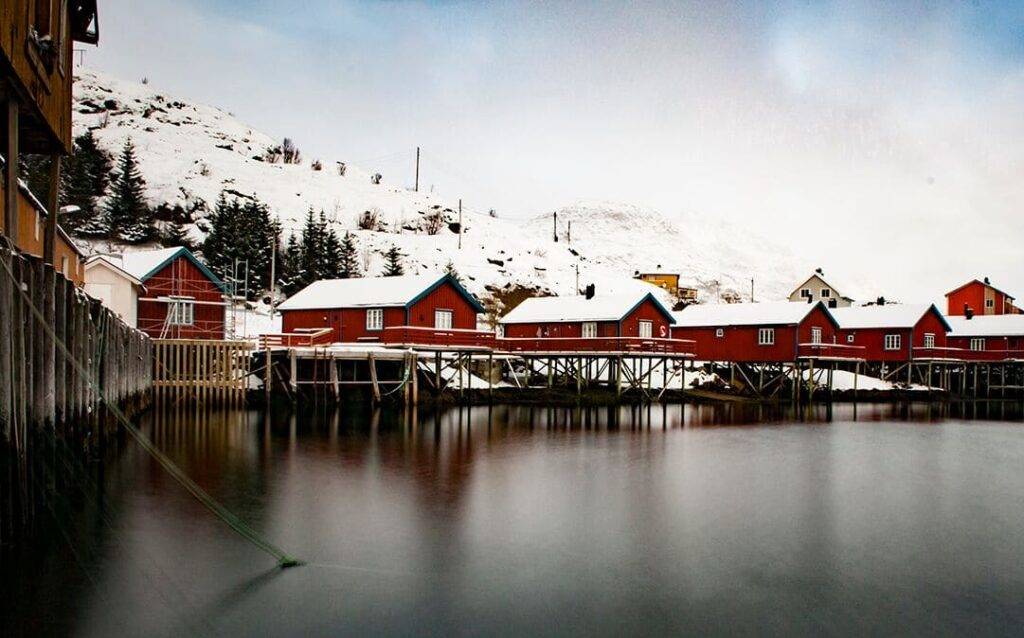
When to go to the Lofoten Islands
Are you planning a trip to the Lofoten Islands and want to know when to go? Checkout below table and find the best month for you to leave for this fantastic land.
| January | The climate is not the best, but in the first days of the year the polar night ends . The sun’s rays begin to warm. It is not the best time to visit the Lofoten Islands. Many restaurants and bars may be closed. |
| February | February is one of the most magical times to visit the Lofoten Islands. The landscape is often covered in a soft white blanket, the sun’s rays amplify the beauty and the first stockfishes begin to be hung up for drying. This is one of the most beloved periods for Northern Lights photographers and hunters. But be careful: it is also the coldest month of the year, with temperatures hovering a few degrees below zero. |
| March | Northern lights hunters and photography enthusiasts will love the month of March. The hours of light extend further, without however compromising the possibility of seeing the aurora dancing in the sky. |
| April | The chances of seeing the northern lights aren’t the best in April for one simple reason: the hours of light are starting to be really long: at the end of the month the sun sets at 10pm. At the same time, however, April could prove to be a very satisfying month for those who want to enjoy the Lofoten Islands with little or no snow and few tourists. |
| May | The hours of light are many, indeed many. So much so that at the end of the month the sun never sets again and the phenomenon of the midnight sun begins. |
| June | June is the absolute month in which to witness the phenomenon of the midnight sun and wonderful trekking in nature. But be careful: remember to bring an eye mask with you to help you sleep if you are sensitive to light. |
| July | The perfect month to test the Norwegian summer. The climate is summery, but don’t be fooled: dressing like an onion and always having sunscreen with you is always a good idea. From the middle of the month the sun begins to set again, but there will still be many hours of light. Remember the sleep mask . |
| August | August is a month when thousands of tourists visit the Lofoten Islands. If you’re planning a trip during this time, be sure to book your stay well in advance, or consider sleeping in a tent with several other campers. |
| September | Summer is officially over, tourists are reduced and travelers with a little luck, will be able to witness the first northern lights of the season. |
| October | The rainiest month, even if the weather in the Lofoten Islands is always quite uncertain. A trip in this period is not recommended due to the sky being overcast. |
| November | A rainy and windy month, in which the days are getting shorter and shorter in anticipation of the polar night scheduled for December. If the sky is clear, however, the aurora borealis will color the sky above the rorbuers (the typical fishermen’s houses). |
| December | Month to witness the polar night phenomenon . The hours of light are reduced to a minimum, the rhythms are slow and the houses light up with Christmas lights and decorations. The very scarce light makes this period not recommended for those who want a photographic trip, but ideal for those who want to experience the phenomenon of the polar night. The tourist turnout is low and the holidays are deeply felt by Norwegians, for this reason many businesses such as bars and restaurants may be closed. Supermarkets are often only open every other day. Always carry supplies with you. |
As you may have easily guessed, there is no “the” best time to organize a trip to Lofoten: every month and every season has a lot to offer.
The winter months are perfect for Northern Lights hunters or those who want to experience the phenomenon of the polar night firsthand.
On the contrary, the summer months are perfect for those who want to test the phenomenon of the midnight sun and admire the greenery of the Lofoten Islands, but without the northern lights due to the very long days.
Everyone has their own preferences, but to make an informed decision, consider that there are fewer tourists in winter and therefore it will be easier to find a place in the lodgings and typical rorbuer (at a reasonable price).
In this season, however, you must also consider that not all commercial activities will be open and therefore you will have to organize yourself well, especially as regards supplies.
Once you have chosen the period, take a look at the prices of flights to Bodø, the airport where I recommend you land to easily reach Lofoten and save this site to check the weather forecast during your trip.
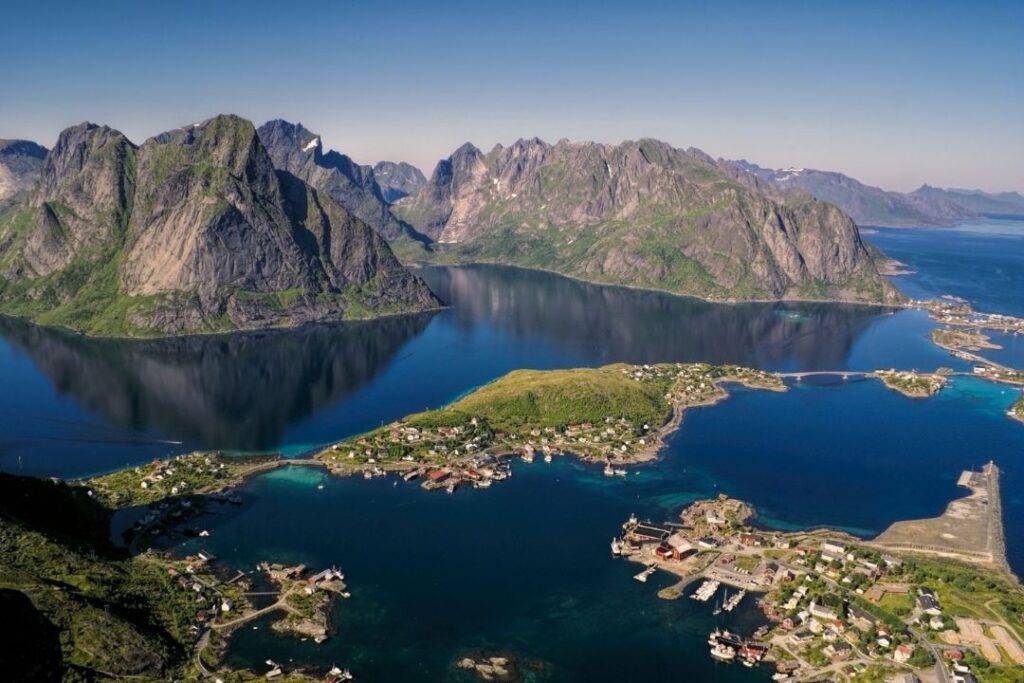
2: How to reach the Lofoten Islands
Reaching the Lofoten Islands might prove easier than expected after gathering the information in the next few lines (promise!).
By plane
To reach the Lofoten Islands by air you will need to buy a ticket to Leknes, right on the Lofoten Islands.
Generally you could find yourself with this combination of flights, depending on the departure airport: a first stop in Oslo – A second flight that will take you to Bodø – and finally a last short leg to be covered generally with a turbo prop that will take you in Leknes (finally on Lofoten).
By ferry
To reach the Lofoten Islands by ferry, however, you will first need to buy a flight to Bodø and from there take the ferry that will take you to Moskenes (on the Lofoten Islands).
Consult this page to find out about rates and timetables that are always updated for the route (which change according to the season).
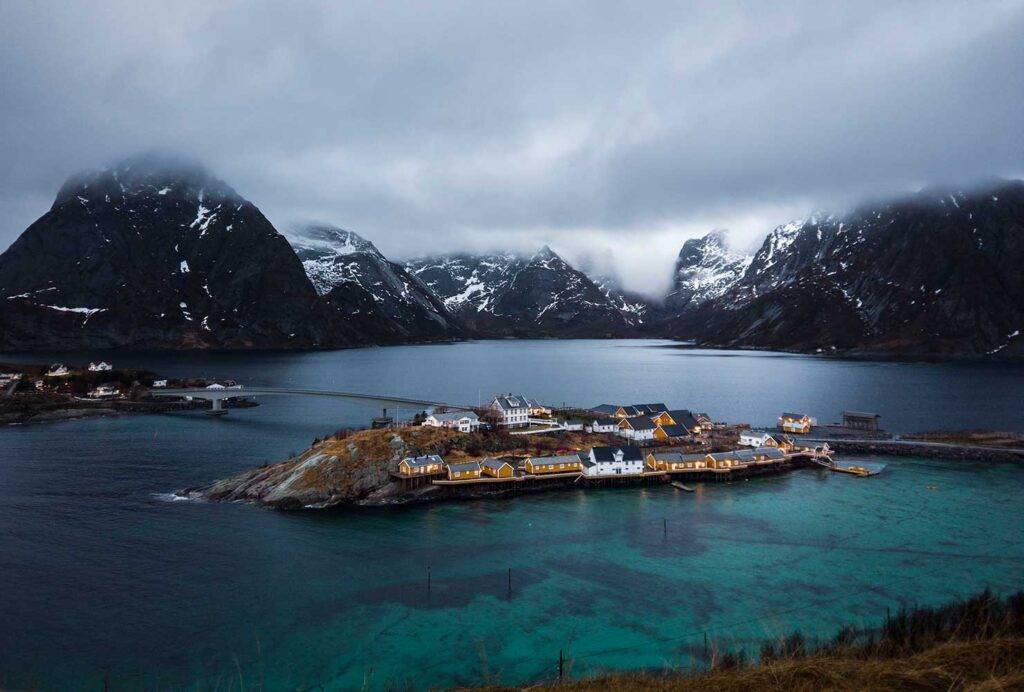
3: What to see and do in Lofoten (in summer and winter)
The Lofoten Islands are an enchanted place, with strips of land that drop straight into the sea, where fishermen have boats parked in the “garden” and the air smells of salt and fish (more fish actually).
What to see and do in this very special land?
What to do in the Lofoten Islands
In the Lofoten Islands you have to observe, assimilate every detail, every facet of man’s work, in this place where every single strip of land does not seem to have been placed there at random. As in a canvas covered with drops of paint from the brush of a great artist: they all have a different shape and above all, they follow a precise order. To the human eye nonsense, but which overall makes the Lofoten Islands one of the most incredible spectacles of nature! You can join some tours to make the most of your trip to the Lofoten Islands :
- Photo tour of the Lofoten Islands in Italian;
- Trollfjord cruise to see the fjords from a different perspective;
- Sea eagle spotting tours;
- Take part in a traditional fishing trip (if available);
- Northern Lights hunt with an Italian guide and professional photographer;
- Exit with guide in Italian to assist and photograph the phenomenon of the midnight sun – starting from May.
Places not to be missed in the Lofoten Islands
Below you will find a short list of what to see, but to learn more I suggest you read the article dedicated to the most beautiful places in the Lofoten Islands where you will also find a map of where they are:
- Hamnøy: one of the oldest and most artistic fishing villages in the Lofoten Islands;
- Henningsvær: an ancient village which until 1981 was only accessible by sea. Today it is famous for the soccer field on a strip of land and connected by several bridges;
- Reine: a village with a privileged location, surrounded by peaks and with a dream view of the Reinebringen;
- Svolvær: the main city of the Lofoten Islands;
- Å: the country with the shortest name in the world, as well as the last village south of the Lofoten Islands. It is no coincidence that “Å” is also the last letter of the Norwegian alphabet;
- Rambergstranda: an incredibly white sand beach ;
- Flakstad Church: a red , typically Norwegian church ;
- Sakrisøya hillock: a small hillock from which to admire the fjords from above: Reine, Sakrisøy and Hamnøy;
- Sakrisøy cottage: an ocher house, perhaps the most photographed on the Lofoten Islands;
- The stockfish museum : to visit to get an overview of the lifestyle of the inhabitants of the Lofoten Islands and their traditions;
- The bridges of Fredvang : a place to understand the craftsmanship of the man who has made this place a beautiful place to live.
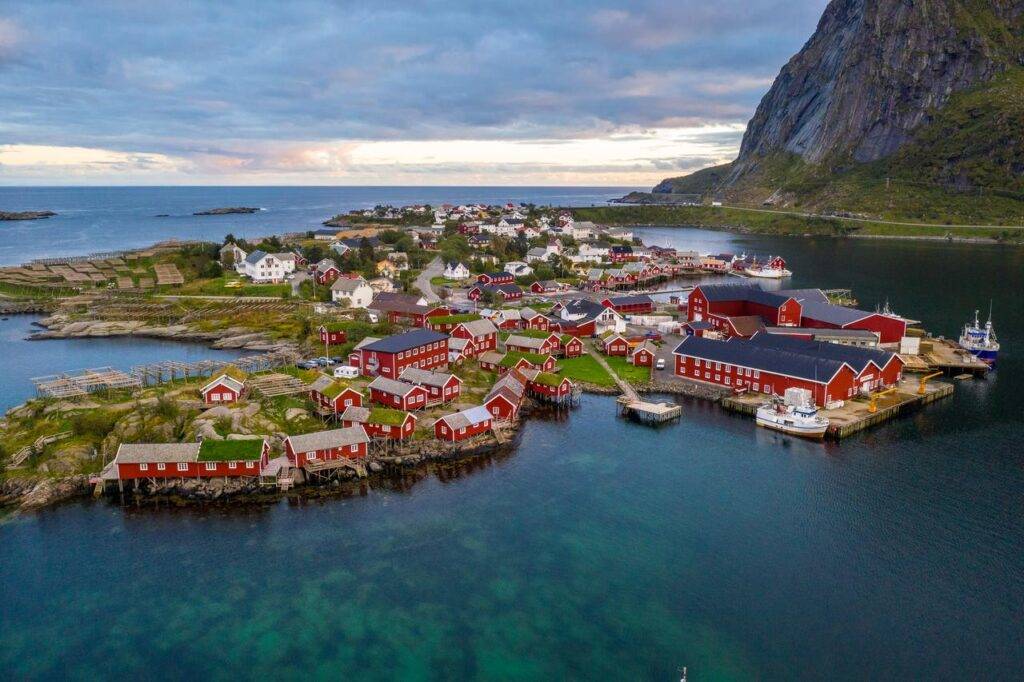
4: Travel itinerary in Lofoten
Planning your trip to the Lofoten Islands should be really easy now that you’ve read the insider tips on how to get there and what to see. But to make your job even easier, I’ve decided to share with you my itinerary to the Lofoten Islands from which you can take inspiration to organize yours. Below you will find it extremely summarized, but then you can learn more in the dedicated article.
7-day itinerary in Lofoten:
- Day 1 : Bodø – Moskenes
As soon as you land at Bodø airport, rent a car and board the ferry towards Moskenes. Spend the night in Å, staying in a typical rorbu at Å-Hamna Rorbuer or in a room at Brygga Restaurant and Rooms (cheaper). - Day 2 : visit Å and trek to Reinebringen
Weather and season permitting, in the morning you will take the most famous trek in Lofoten: Reinebringen. Spend the second night at Å-Hamna Rorbuer or Brygga Restaurant and Rooms. - Day 3 : Reine, Sakrisøy and Hamnøy
Visit the fishing village of Reine and join the beautiful boat tour on the Reinefjorden. Then go to the island of Sakrisøya and spend the night in Sakrisøy Rorbuer or in this Bed & Breakfast in Reine. - Day 4 : Fredvang, Ramberg, Flakstad and Nusfjord
See the bridges of Fredvang, the beach of Ramberg, the church of Flakstad and reach Nusfjord, the oldest fishing village in Lofoten. Spend the night at Nusfjord Arctic Resort or Lofoten Cottages. - Day 5 : Henningsvær Trekking & Sunset Cruise
In the morning visit Henningsvær and (weather permitting) trek to Festvågtind for spectacular views of the fjords. Before dark reach Svolvær where you can consider an evening cruise with tasting. Spend the night in town at Svinøya Rorbuer or Thon Hotel Lofoten. - Day 6 : Svolvær and Eagle Tour
Visit the small town of Svolvær and take a classic eagle tour. - Day 7 : Svolvær and return
If you still have some time you could treat yourself to a trek to the Fløya trail head, to enjoy a nice view of the city. Depending on your flight schedule, either return to Bodø or continue your journey north.
This tour of Lofoten is indicative only, although in my opinion it is the best to get a taste of this magnificent land. Check out the full version of the Lofoten Islands Itinerary and feel absolutely free to customize it according to your dates needs and your tastes and preferences.
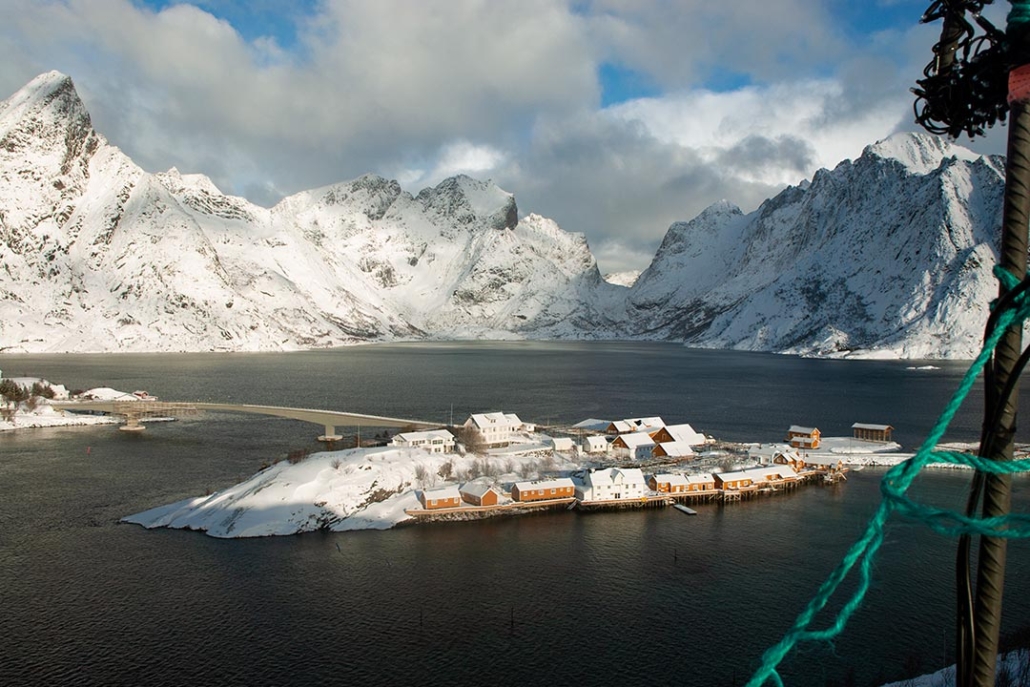
5: Where to stay in the Lofoten Islands
Another thing you shouldn’t miss about living in the Lofoten Islands?
Staying in the rorbuer, the typical fishermen’s cottages.
I could not fail to include in this summary page on how to organize a trip to Lofoten, the overnight stay.
Why? Because staying in a rorbu in Lofoten is a way to get in complete harmony with this land: consider staying in a rorbuer during your trip, even changing the structure from time to time.
But what are rorbuers?
The rorbuers are nothing more than the old wooden houses, typically painted red, that you will see on the coasts: overlooking the sea and built on stilts, they are the old lodgings where the fishermen took refuge. Many of these have been refurbished and are rented out to tourists.In this guide I have enclosed my selection of best rorbuers in the Lofoten Islands.

The most beautiful rorbuers in the Lofoten Islands
You will be spoiled for choice in which rorbu to stay but, in my view, two establishments stand out above all:
- Å Hamna Rorbuer : in the country with the shortest name in the world “Å”
- Sakrisøy Rorbuer : these rorbuers are on an island connected to the rest of Lofoten by 2 bridges. For me, this accommodation was the first in which I stayed in a rorbu in Lofoten, so it was particularly special. On this small island you will also find a restaurant.
The electric heating, the wooden walls and the small windows will make your stay in a rorbu something unforgettable.
Generally they are real miniature houses, also equipped with a kitchen. It is usually difficult to find availability in the rorbuers in high season: for this reason I recommend that you take a few minutes of your time to check availability on your dates and book your accommodation on Booking.
Read more in the article or consult the practical map, where you will see the accommodations divided by price range, but remember to enter your travel dates first.
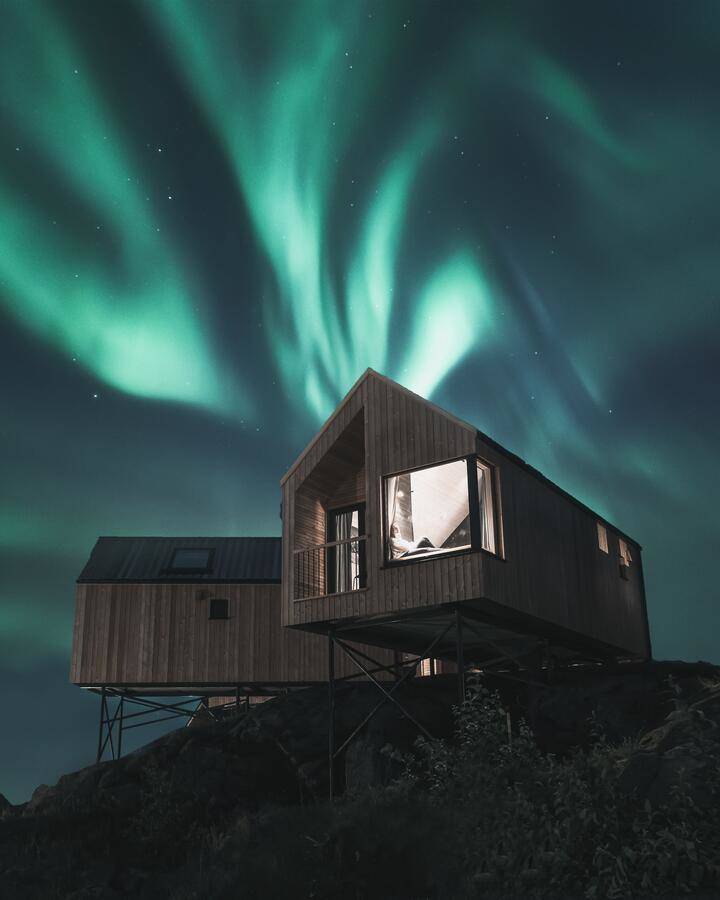
6: What to pack
“Det finnes ikke dårlig vær, bare dårlige klær!”
It is Norwegian and means: “There is no bad weather, only bad clothes!”.
Ok, Norwegians are quite realistic, so here’s what to wear for your trip to Lofoten, so you don’t wear bad clothes.
As the primary school teacher and mother used to say when you began to choose how to dress yourself: “Dress like an onion, if you’re hot at most you’ll undress”.
That’s right, even for your trip to Lofoten, you’ll need to think about layered clothing, ready for any eventuality: from rain to sun, from snow to strong winds!
With the weather so changeable, you have to try to be exactly like him. Or like a snake shedding.
In short, you must be ready to undress and get dressed again at any time (don’t worry, nothing dirty eh ), so dress in 3 layers (to be modified according to the season):
1. First layer: socks and technical underwear.
2. Mid Layer: Heavy sweaters and pants.
3. Third layer: if it’s late winter, a ski suit is perfect.
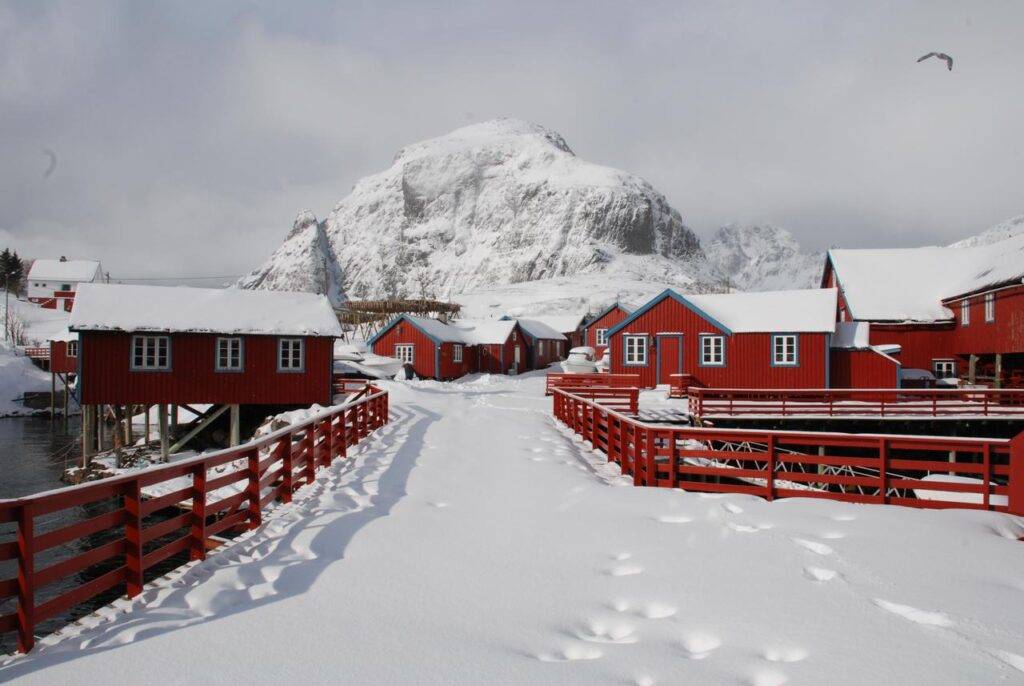
7: How much does a trip to the Lofoten Islands cost
One thing will never stop making me smile: the face people make when I answer the question: “ How much does a DIY trip to the Lofoten Islands cost? ” and I say a figure with fewer zeros than they expect.
The opposite is also true: it will amaze many, my puffer fish face with bulging eyes when they tell me how much they spent on a cruise among the Norwegian fjords.
In summary, here is the cost to reach the Lofoten Islands : 180 € plane ticket to Bodø + 15 € night in Gdansk + 60 € per person the ferry with the car to reach Moskenes (or 234 NOK about 24 € the ticket for an adult only without car).
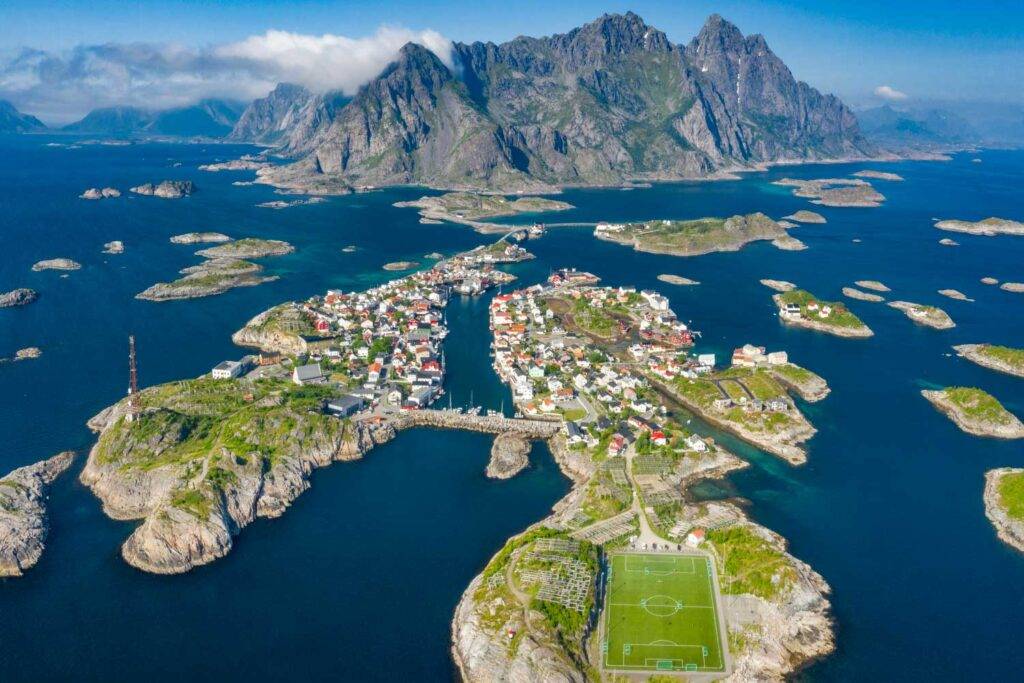
Cost of a trip to the Lofoten Islands
| Cost of airfare | 180€ |
| Cost of accommodation in Gdansk (due to a long layover) | 15€ |
| Price of the ferry from Bodø by car | 60€ |
| Car rent | 142€ |
| Stays in various rorbuers | 370€ |
| Food (almost always cooking at home) | 75€ |
| Fuel | 68€ |
| Ferry to Værøy with car | 22€ |
| Total cost for a 7 day Lofoten trip | 932€ |
VIDEOS AND WEBCAMS OF THE LOFOTEN ISLANDS
Do you want to feast your eyes or know what this trip will have in store for you? Check out the videos shot in the Lofoten Islands and the live webcam ( click here ).
DID YOU KNOW THAT..
The main activity in Lofoten is fishing (and the Italians are the historic importers of stockfish): the stockfish is dried on wooden structures that you will see scattered here and there. Be careful though: stockfish are fished from January to April, so if you go during the polar night in December for example, you won’t be able to see any hanging (or you will see very few).
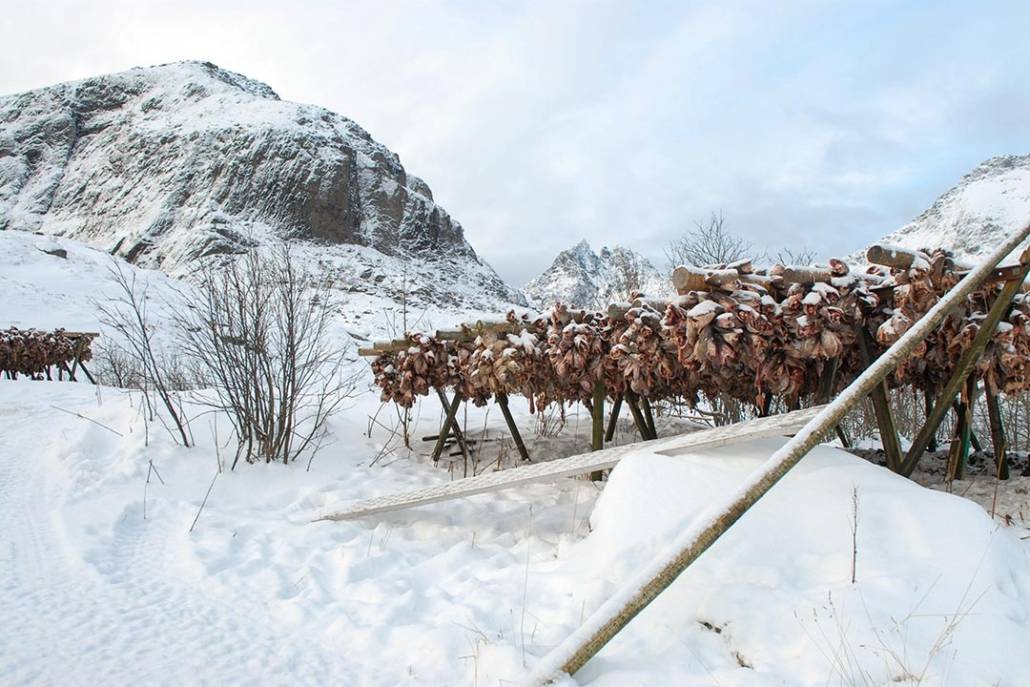
FAQ – Questions with answers
1: Where are the Lofoten Islands located?
The Lofoten Islands are located in Northern Norway and are about 200 km north of the Arctic Circle. They are immersed in the cold waters of the Norwegian Sea that fit between one fjord and another, offering breathtaking scenery in every season.
2: When to go to the Lofoten Islands?
If you want to witness the polar night phenomenon, I recommend going to the Lofoten Islands in December. The best months to enjoy a Northern Lights hunting trip are February and March.
If, on the other hand, you want to experience the phenomenon of the midnight sun firsthand, you will have to organize a trip to the Lofoten Islands from late May to mid-July.
3: What to see and do?
Breathtaking landscapes, fjords, fishing villages and dried stockfish targeted by seagulls. In the Lofoten Islands every glimpse is to be seen and experienced, because every inch contains so much beauty in all seasons of the year.
Did you like and above all was what you read useful to you? Do you have any questions or suggestions on how to organize a trip to the Lofoten Islands?
Let me know by leaving your comment below.
Are you going to Norway? Read also:
- Discover all our articles about Norway: all articles about Norway are listed here.
- Where To Stay In Lofoten Islands: 10 Spectacular Rorbuers – best rorbuers in the Lofoten Islands
- Lofoten Islands Itinerary: Ultimate 1 week Itinerary
- Top 14 Things to Do and See in Lofoten Islands




